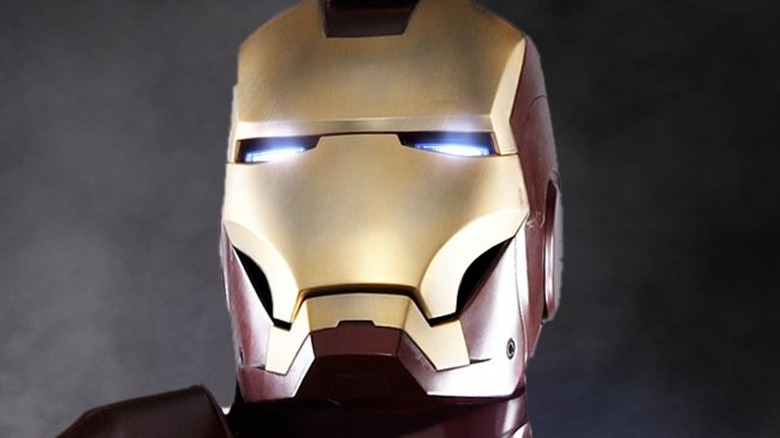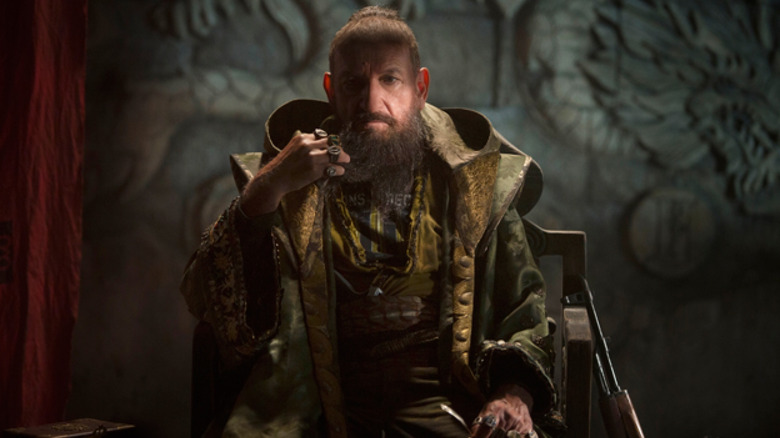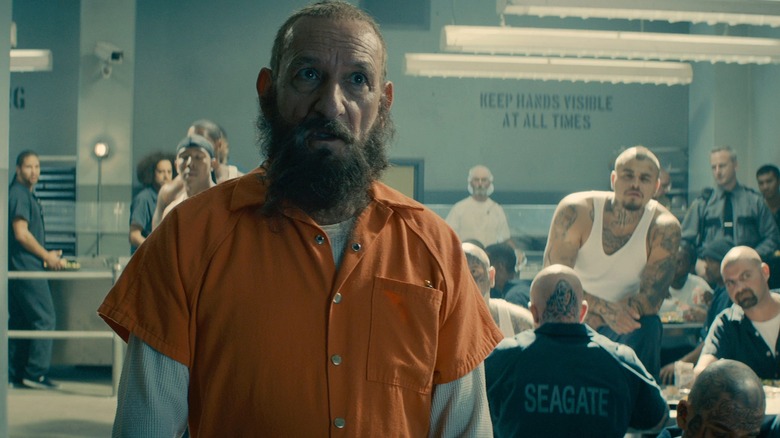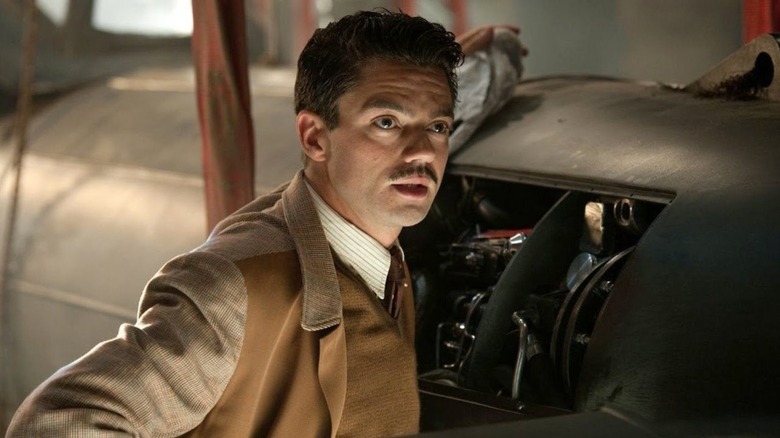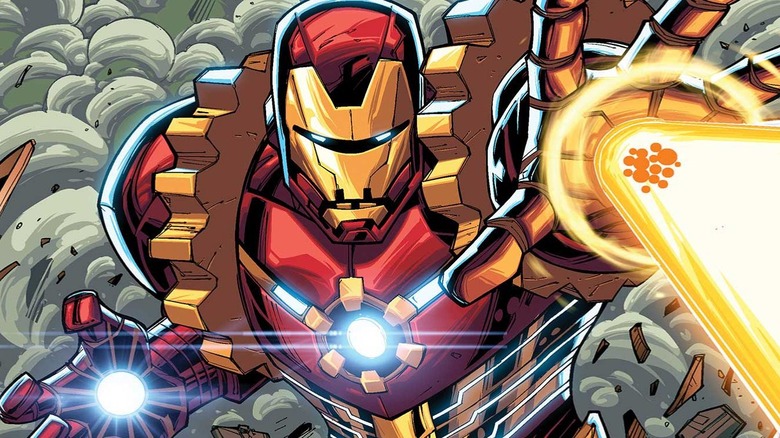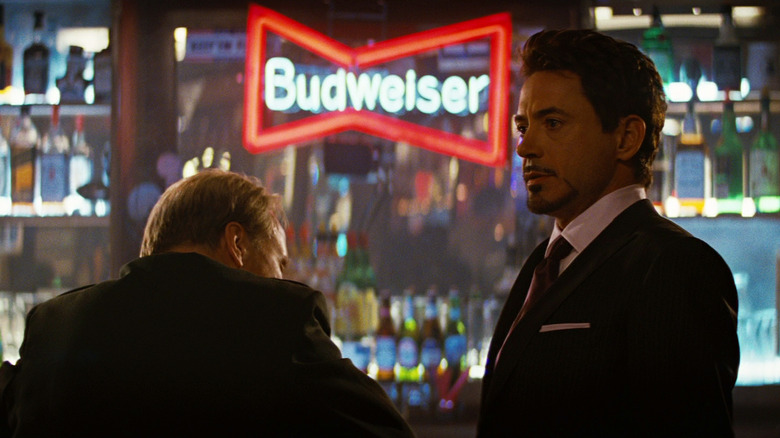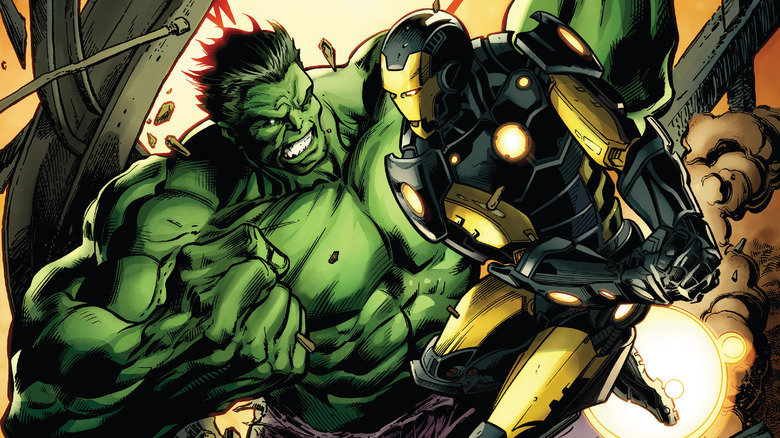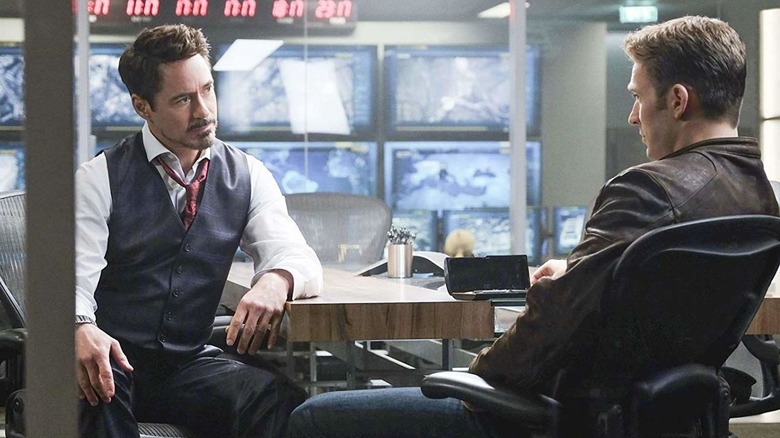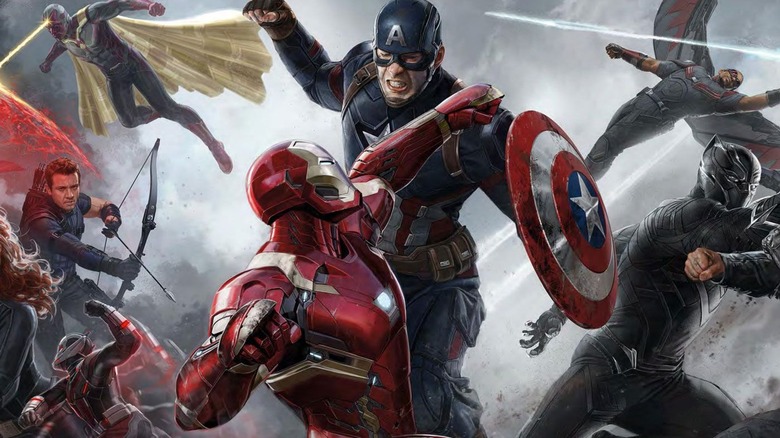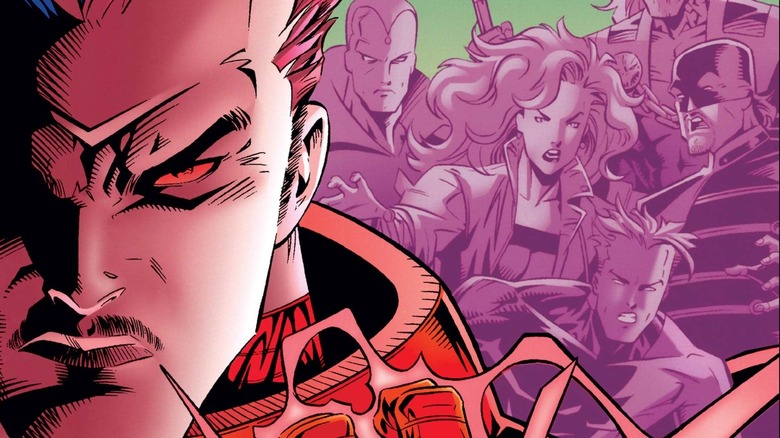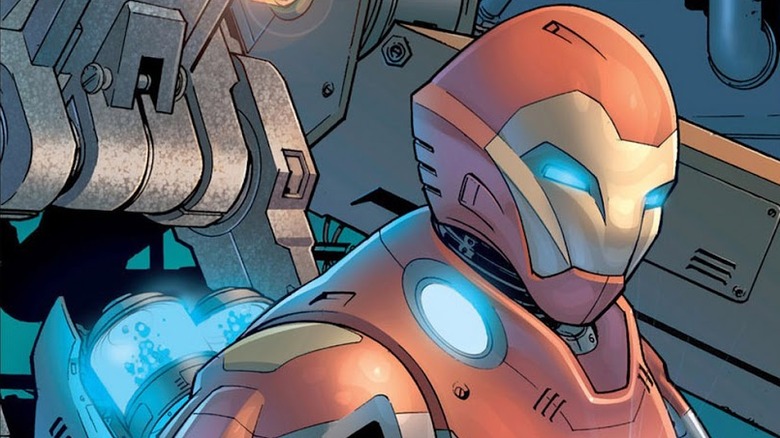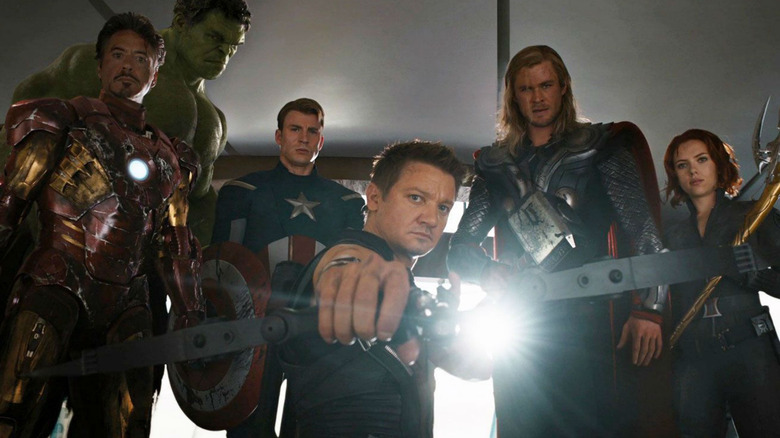Ways Marvel Lied To You About Iron Man
Ever since the 2008 release of Jon Favreau's "Iron Man," the then B-list superhero has rocketed into stardom and become one of the most recognizable Marvel characters on the planet. Not only did Tony Stark receive a trilogy of movies and play major roles across countless others, the introductory era of the most successful movie franchise in the history of cinema began and concluded with his first and last appearances. He is the face of the Marvel Cinematic Universe, and even though his on-screen story is over for now, it's difficult to imagine anyone else taking his place anytime soon.
All this has come, however, with a bevy of lies designed to mislead, distract, and otherwise bamboozle Marvel's comic book-reading and movie-going audiences in order to introduce new twists, retcon old stories, and incorporate new story idea into the fold. Whether it's trailers that totally aren't hiding the real villain or a secret sibling that Tony definitely had the whole time, here are a slew of lies that Marvel has sold Iron Man fans alongside the hero.
The Mandarin is the villain of Iron Man 3
The most infamous lie that Marvel told fans was that the villain of 2013's "Iron Man 3" was the Mandarin. Originally introduced in the comics in 1964's "Tales of Suspense #50," the Mandarin is one of Iron Man's oldest and most famous villains, and despite the character's roots as a "Fu Manchu" stereotype, fans were excited to see Iron Man's archenemy finally make his way to the silver screen.
Those fans would be disappointed — and others delighted — by the actual film. Towards the end of the second act, Iron Man tracked down the man that threatened his life, blew up his home, and had been generally destroying his life. But when Tony came face to face with the man, he discovered that the "Mandarin" never actually existed. Instead, he had been an oblivious, washed-up actor named Trevor Slattery the entire time, and Aldrich Killian was the real villain all along.
Although it was an interesting twist from writer/director Shane Black, and one that garnered positive responses from many, comic book fans saw their beloved Mandarin as nothing more than a prop in a shell game.
The Mandarin doesn't exist in the MCU
Despite its marketing, "Iron Man 3" seemed to confirm that, in the MCU at least, there was no person named the "Mandarin." Instead, it was just an actor named Trevor Slattery playing a character that Aldrich Killian made up. It wasn't long, however, that Marvel decided to back-track on that decision.
In 2014, Marvel released a short film featuring Ben Kingsley's Trevor Slattery titled "All Hail the King." The one-shot followed Trevor as he served his time in prison in between interviews with a reporter. At the end of the film, the reporter revealed that he worked for the real Mandarin, who "wants his name back." Kingsley was then taken away and presumably brought to the real Mandarin and likely killed.
So essentially, Marvel's greatest Iron Man lie was also a different, smaller lie. It is because of this retcon that "Shang-Chi and the Legend of the Ten Rings" could use the Mandarin and his criminal organization as the central antagonists. Though this isn't the Iron Man showdown that many fans were dreaming of, it is still nice that one of Marvel's oldest villains will finally still make it to the big screen in one form or another — this time, apparently, for real.
Tony is Howard and Maria Stark's son
The Marvel Cinematic Universe has placed a surprising amount of focus on Tony Stark's troubled and broken relationship with his parents, Howard and Maria Stark. Not only did Tony's father appear in some form in the majority of Tony's MCU appearances, the man also appeared in the otherwise unrelated film "Captain America: The First Avenger." Anybody that wants to understand Tony's personality in the MCU must know Howard, because that defines the hero's character more than almost everything else.
In the comics, however, this is not the case. For instance, Howard was not introduced until 1970 in Iron Man #28, a full seven years after Tony's invention in Tales of Suspense #39 in 1963. This divide was further enhanced by a controversial story in 2013 in "Iron Man" #17, which firmly established that Tony was adopted. Howard and Maria were not his biological parents after all.
It would be another three years before Tony finally discovered his biological mother, a former agent of SHIELD named Amanda Armstrong. She had met Tony's father, Jude, while they both worked for SHIELD, and gave Tony to the Starks to keep him safe after she discovered that Jude was secretly a Hydra double-agent.
Iron Man is an only child
In 1984, Marvel Comics introduced a possible future version of Iron Man in "Machine Man #2" named Arno Stark, who hailed from the far-off future of 2020. When the real-world year of 2020 eventually rolled around, Marvel decided to fully introduce the character as Iron Man into Earth-616, the primary Marvel Comics Universe. This Earth-616 version of Arno Stark was actually introduced back in 2013 in "Iron Man" #12 and was 17 when Tony discovered he was adopted.
The reason that Howard and Maria had decided to adopt was because their first attempt to become parents had ended in disaster. Arno was seemingly born without the ability to breathe and wasn't expected to survive, even after Howard made a secret deal with space aliens and then double-crossed them to get life-saving technology. Arno was placed on artificial life support using iron lungs and hidden away, and the Starks adopted Tony to hide their treachery from their alien benefactors.
When Tony eventually discovered Arno's existence, he created a set of iron lungs that would allow him to actually live his life, and it wasn't too long afterwards that Arno first put on a suit of Iron Man armor in "Tony Stark: Iron Man" #19 at the very end of 2019. Arno operated as an Iron Man for most of 2020, until his attempts to permanently cure his disease ultimately drove him insane and forced Tony to trap him within a virtual reality simulation.
Tony was sent to recruit Banner in The Incredible Hulk
Movie-goers were shocked when Nick Fury appeared at the end of 2008's "Iron Man" to tell him about the Avengers Initiative. They were shocked again when Tony Stark appeared at the end of "The Incredible Hulk" later that same year. Supposedly, Tony had been successfully recruited by Nick Fury and was now trying to recruit Edward Norton's Banner, but "Iron Man 2" and, eventually, "The Avengers" made it pretty clear that this couldn't have been the case.
Because of this, Marvel produced another one-shot titled "The Consultant." Released in 2011, it revealed that Marvel fans had been lied to. Tony wasn't there to attempt to recruit Bruce Banner; he was there to recruit Emil Blonsky, the Abomination. SHIELD knew that, unlike the Hulk, Blonsky actually was a monster and did not want to recruit him, despite having direct orders to do so.
To make sure the recruitment didn't happen, SHIELD Agents Jasper Sitwell and Phil Coulson hatch a plan to send someone so inept, arrogant, and annoying that General Ross would never agree to release the Abomination into SHIELD's custody. Thus, they sent their consultant, Tony Stark, who bombed the meeting accordingly and was none the wiser.
Iron Man purposefully turned Bruce Banner into the Hulk
In 2014, Marvel released its latest event: "Original Sin." The premise of the storyline was that, after Uatu the Watcher was assassinated, the cosmic being's eyeball was used to release a wave of energy that revealed "dark secrets" to everybody it impacted. For Bruce Banner and Tony Stark, this meant that Banner finally knew that Tony had meddled with the Gamma Bomb that turned him into the Hulk. The world finally knew. Iron Man had created the Hulk, and it was on purpose.
Except of course, it wasn't. This "dark secret" didn't turn out to be that big of a deal, and after yet another battle between Banner and Tony's latest Hulkbuster Armor, Iron Man was finally able to explain that he hadn't rigged the bomb to explode or purposefully affected it in order to create a living green rage monster. Instead, he had secretly corrected some errors in Banner's calculations that better controlled the bomb's blast radius.
If Tony hadn't done this, Banner would not have been transformed into the Hulk. He would have been completely incinerated and instantly killed by the blast. So technically, Iron Man was responsible for creating the Hulk but only because he saved Banner's life. So, after following the superhero tradition of punching before talking, the pair parted as friends once again.
Iron Man and Captain America are friends in the MCU
"Sorry Tony ... he's my friend."
"So was I."
It's a famous set of lines. It was shown throughout the movie's trailers, and when the dialogue was finally delivered by Robert Downey Jr and Chris Evans in "Captain America: Civil War," it was an appropriately heavy moment, but just how true was it? Were Tony Stark and Steve Rogers actually friends? Despite the movie's claims to the contrary, this is likely another lie that audiences were told by the creators at Marvel.
Though the pair's long-standing friendship in the comics can make this easier to overlook, movie-goers never actually saw Tony or Steve acting all too friendly. When they first meet in "Avengers," the pair are immediately hostile towards one another, and though they do figure out how to work together to save the world, they don't really share many bonding moments. The actual event doesn't seem to count either, as Steve still isn't friends with Black Widow either by the time "Captain America: The Winter Soldier" rolls around.
Add to this the fact they spend most of "Avengers: Age of Ultron" acting out a sort of "Civil War" prequel, and the two have spent almost all of their time onscreen disliking, disagreeing, and outright punching each other and have spent very little of it actually being friends. In fact, their "language" gag at the beginning of "Age of Ultron" is one of the only times fans actually saw them getting along.
Iron Man is the villain of Captain America 3
When 2016's "Captain America: Civil War" was being promoted prior to its release, a big deal was made out of the fact that the villain for Captain America's third film was going to be Iron Man himself. This wasn't going to be "Avengers 2.5," they assured us, but was instead going to be a Captain America film that just so happened to feature the Avengers, and while a viewer's mileage may vary on how much they believe that statement, the movie itself made it crystal clear that Iron Man was not the movie's villain — it was Baron Zemo.
Brilliantly played by Daniel Brühl in both "Civil War" and "The Falcon and the Winter Soldier," Zemo was the one pulling the strings behind the scenes for the entire film. If it wasn't for him, the Avengers never would have fought or split at all. Zemo knew he couldn't kill the Avengers, so he made them try to kill themselves and ended the team as fans knew it in the MCU.
Iron Man was a villain all along
In 1995, Marvel decided that it would be a brilliant idea to release a 6-part miniseries titled "Avengers: The Crossing." The event saw the Avengers battle their old, time-traveling foe "Kang" for the millionth time, but in this story there was a twist. Iron Man had been Kang's evil double agent for his entire life. Basically, this meant that Iron Man had secretly been evil for the entirety of his publication history.
For the 32 years that fans had been reading the character, every heroic action, every noble, private thought, every moment he had spent internally worrying about the safety of those he loved, all of it had been a lie. This flew in the face of every Iron Man story fans had ever read — so as you might imagine, it was not well received.
What made it worse was that the Avengers decided the best solution to evil Tony was to bring his teenage self from the past to don an Iron Man armor to take down the evil adult Tony. Thankfully, this storyline was quickly, completely, and totally abandoned after the 1996 reality-rejiggering event, "Heroes Reborn."
Ultimate Iron Man's first origin story was a cartoon
Written in 2005 by Orson Scott Card, the author of "Ender's Game," the 2005 "Ultimate Iron Man" comic book miniseries was the first attempt to establish Tony Stark's origin within Marvel's "Ultimate" universe, a publishing initiative whose main goal was to create an alternate universe to explore what Marvel's classic characters might be like if they were created in the 21st century.
Iron Man's first "Ultimate origin" didn't go particularly smoothly, however. Howard and Maria stark, faced with an imminent hostile corporate takeover of their company by the Stanes, decide to rush the development of two experiments that they are forced to test on their son: a blue body paint that protects the user from harm but eats away at the skin, and a virus that causes the regrowth of genetic tissue and turns Tony Stark's entire body ... into a living brain. This is why Tony is smart enough to eventually create his more traditional Iron Man armor to defeat the Stanes and foil their plot to frame his father for murder.
The story was received horribly by fans, and it was looked down upon so fiercely that a writer named Mark Millar spent two whole pages of "Ultimate Avengers vs. New Ultimates" #2 to retcon the entire miniseries and establish the idea that not only did that story not happen, it was actually an in-universe cartoon made for children that was constantly made fun of. Comic books are fun.
Iron Man pays the Avengers
In 2015's "Avengers: Age of Ultron," Tony Stark quips that he isn't the team's boss — that, he says, is Captain America.
Tony, on the other hand, makes it clear that, "I just pay for everything and design everything and make everyone look cooler." Most people, including both the fictional citizens of the Marvel Cinematic Universe and its hordes of fans, understood that statement to mean that Tony literally paid his Avengers teammates. After all, how are the Avengers meant to spend all their time fighting evil and maintain gainful employment?
Fans were surprised to learn in the first episode of 2021's "The Falcon and the Winter Soldier" that the answer is a resounding "good luck." Sam Wilson reveals to a bank loan agent that the Avengers were never paid for their efforts or time on the team, and the bank manager's response is to deny the Avenger a loan before asking for a selfie with the famous hero.
